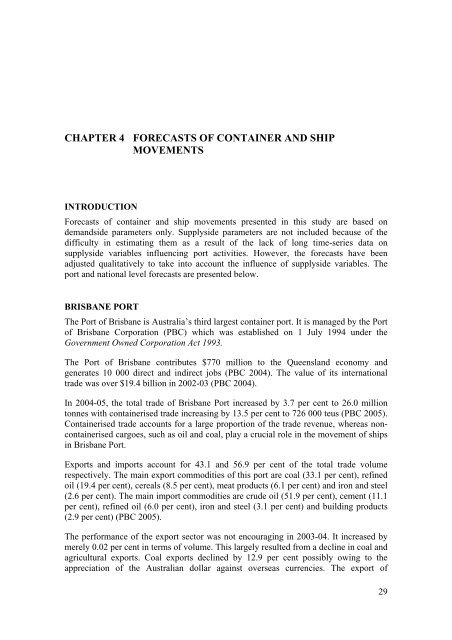PDF: 1336 KB - Bureau of Infrastructure, Transport and Regional ...
PDF: 1336 KB - Bureau of Infrastructure, Transport and Regional ...
PDF: 1336 KB - Bureau of Infrastructure, Transport and Regional ...
- No tags were found...
Create successful ePaper yourself
Turn your PDF publications into a flip-book with our unique Google optimized e-Paper software.
CHAPTER 4 FORECASTS OF CONTAINER AND SHIPMOVEMENTSINTRODUCTIONForecasts <strong>of</strong> container <strong>and</strong> ship movements presented in this study are based ondem<strong>and</strong>side parameters only. Supplyside parameters are not included because <strong>of</strong> thedifficulty in estimating them as a result <strong>of</strong> the lack <strong>of</strong> long time-series data onsupplyside variables influencing port activities. However, the forecasts have beenadjusted qualitatively to take into account the influence <strong>of</strong> supplyside variables. Theport <strong>and</strong> national level forecasts are presented below.BRISBANE PORTThe Port <strong>of</strong> Brisbane is Australia’s third largest container port. It is managed by the Port<strong>of</strong> Brisbane Corporation (PBC) which was established on 1 July 1994 under theGovernment Owned Corporation Act 1993.The Port <strong>of</strong> Brisbane contributes $770 million to the Queensl<strong>and</strong> economy <strong>and</strong>generates 10 000 direct <strong>and</strong> indirect jobs (PBC 2004). The value <strong>of</strong> its internationaltrade was over $19.4 billion in 2002-03 (PBC 2004).In 2004-05, the total trade <strong>of</strong> Brisbane Port increased by 3.7 per cent to 26.0 milliontonnes with containerised trade increasing by 13.5 per cent to 726 000 teus (PBC 2005).Containerised trade accounts for a large proportion <strong>of</strong> the trade revenue, whereas noncontainerisedcargoes, such as oil <strong>and</strong> coal, play a crucial role in the movement <strong>of</strong> shipsin Brisbane Port.Exports <strong>and</strong> imports account for 43.1 <strong>and</strong> 56.9 per cent <strong>of</strong> the total trade volumerespectively. The main export commodities <strong>of</strong> this port are coal (33.1 per cent), refinedoil (19.4 per cent), cereals (8.5 per cent), meat products (6.1 per cent) <strong>and</strong> iron <strong>and</strong> steel(2.6 per cent). The main import commodities are crude oil (51.9 per cent), cement (11.1per cent), refined oil (6.0 per cent), iron <strong>and</strong> steel (3.1 per cent) <strong>and</strong> building products(2.9 per cent) (PBC 2005).The performance <strong>of</strong> the export sector was not encouraging in 2003-04. It increased bymerely 0.02 per cent in terms <strong>of</strong> volume. This largely resulted from a decline in coal <strong>and</strong>agricultural exports. Coal exports declined by 12.9 per cent possibly owing to theappreciation <strong>of</strong> the Australian dollar against overseas currencies. The export <strong>of</strong>29
















